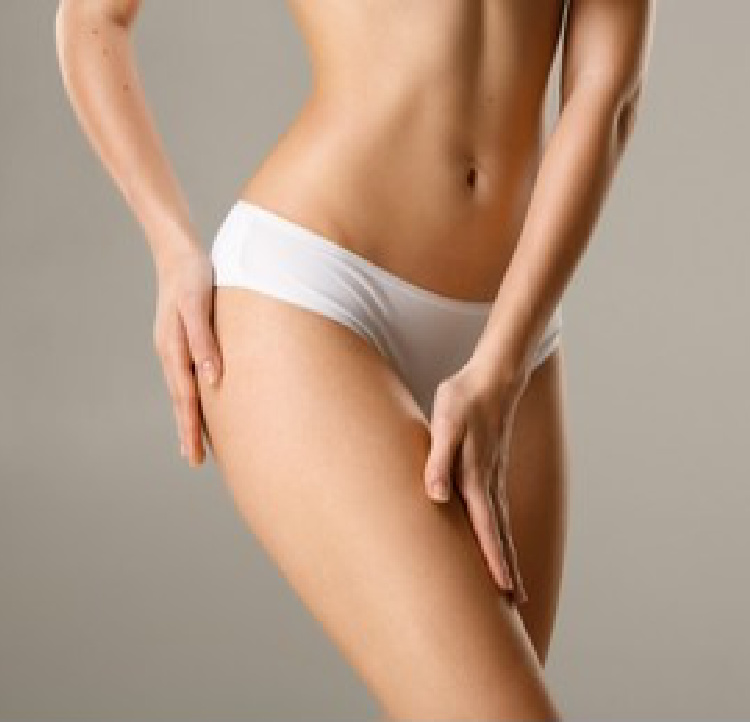Procedure
Thigh Lift
When Should I Consider a Thigh Lift?
- Significant loss of skin elasticity and skin looseness in the inner thigh; typically as a result of weight loss.
- Inner thigh skin area is saggy and has a flabby and/or dimpled appearance.
- A more toned appearance results, when I lift upward on the inner thigh skin.
Anticipated Result:
- A more pleasing and toned appearance to the inner thighs.
- Tightening of the inner thigh skin.
- A more flattering figure in clothing.
- A noticeable improvement to the appearance of the skin surface irregularities.

Philosophy
The Gillian Institute’s body contouring and reshaping philosophy is based on maintaining the feminine contours of the body. Our doctors will only recommend a contouring procedure such as a thigh lift procedure if the risk vs benefit ratio is maintained with favorable beneficial results.
Procedure
The medial thigh lift procedure is not performed commonly due to the location of the incision and the high risk of separation of the incision due to the location. The incision is difficult to heal well due to the location and the high risk of tension related to positioning and using the lower extremities post operative.
The inner thigh lift procedure is recommended and performed most commonly with weight loss patients, whom have lost 100 lbs or more and are experiencing a high degree of excess skin laxity, stretch marks, and overhanging skin to the inner thighs. The incision begins in the upper inner thigh crease and extends downward to the vaginal or pubic area and around to the buttock crease (infragluteal crease). In many patients, a vertical incision is made in the inside aspect of the inner thigh to tighten the skin in the vertical plane as well. The vertical incision is made in the upper inner thigh region and extended downward towards the knee area to address the significant amount of skin sagging and laxity. The inner thigh skin and tissue is tightened in the inner thigh area resulting in a more toned, tight appearance. The incision is concealed but is slow to heal because of the placement in the vaginal area and extension requiring a recovery period that limits positioning, activity level, and undergarment use.
The incision tends to be moist and can be difficult to keep dry and is at an increase risk to separate due to the high amount of tension related to positioning and swelling. Due to the high risk of incision separation, the risk vs. benefit ratio for the medial thigh lift procedure is evaluated and discussed during the consultation. Liposuction is performed at the same time or prior to the thigh lift procedure for optimal contouring purposes. No amount of exercise or weight lifting program will result in an improved appearance of the inner thigh skin redundancy, but typically weight loss will produce more excess skin.
The future of plastic and cosmetic surgery will evolve to address the skin laxity in such a difficult area as the inner thigh with recommendations based on non-surgical skin tightening options. Currently, the technology has not produced a permanent, predictable tool for skin tightening with visible, significant results. But this advancement will be available soon for patients.

Precautions
Patients are required to stop smoking and use of all tobacco products a minimum of 6 months prior to surgery to decrease the risk of complications related to healing and decreased blood flow to the tissue and skin resulting in skin necrosis and incision separation. Smoking has been shown to decrease blood flow by 30% to the incision and tissue resulting in complications related to healing, which will significantly increase the recovery period. Ideally, the longer the smoking has ceased the better in terms of reducing the risk of complications. We would also recommend you are within 15-20 lbs of your ideal body weight to optimize the final result and to decrease the risk of complications related to healing.
AFTER SURGERY
Patients should refrain from vigorous activities for at least 6-8 weeks. Light dressing are placed after surgery and skin glue adhesive with steri-strips in combination with clips are placed along the incision for one to two weeks. A scar treatment for the incision is started at two to three weeks after surgery to improve the scarring. Light activity including ambulation every 2-3 hours is recommended within the first 1-2 weeks and will become more comfortable over 3-6 weeks after surgery. Patients will have a drain placed to each inner thigh and will not be allowed to shower until the drain is removed in the office.
Topifoam compression pads are placed under the compression device for the first 1-2 weeks to reduce swelling and encourage skin contraction. The compression device is recommended for the first 6 weeks to reduce swelling and provide support.
The majority of swelling will be resolved by 8-12 weeks. Post-operative external ultrasound is also recommend to reduce swelling, areas of firmness, and encourage the lymphatic system to positively respond to the swelling and healing process.
Light activity is possible within 12-14 days and will become more comfortable over 2 -3 weeks postoperative. If a separation to the incision occurs post-operative, antibiotic ointment or dressing changes are performed and the incision will heal within a few months completely. After one year following the surgery, a scar revision to the area(s) will be evaluated and discussed.
Note: It is important to address any concerns with The Gillian Institute at the time of your consultation. There is some risk, as with any surgical procedure. Minor complications that do not affect the final outcome occur occasionally. Major complications are unusual. Our doctors can explain the procedure and potential complications to you in detail, and she can assist you in determining if a thigh lift is right for you.